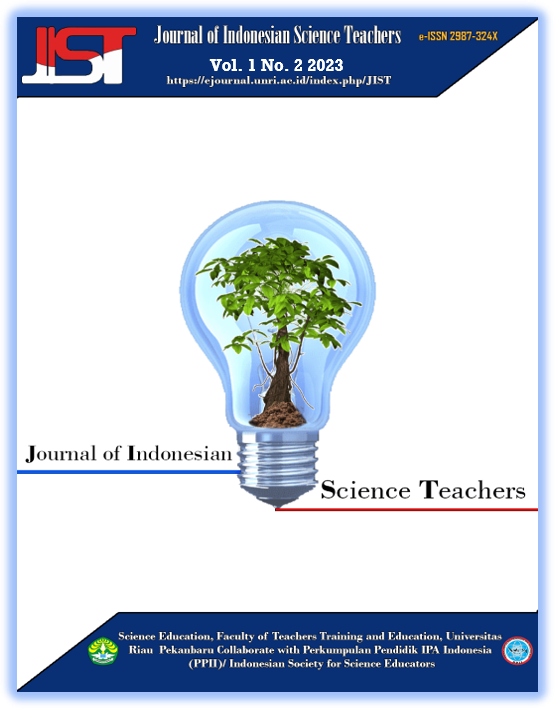Practicality of Using Alternative Energy Project Media in High School Physics Learning
Keywords:
practicality, project media, alternative energyAbstract
This development research aims to test physics learning media on alternative energy materials that have been designed and tested. The type of research used is Research and Development adapted from the theory of Borg and Gall. The learning media developed consists of experimental projects and project use books. The alternative energy media that has been developed consists of 3 projects, namely simple garden lights, simple watermills, and simple windmills. Data collection was carried out through practicality assessment sheets assessed by teachers and students. Aspects of the experimental project assessed include aspects of ease of use of tools and materials, ease of understanding the material, ease of packaging tools, usefulness, safety, and attractiveness. Meanwhile, the assessment aspect for the project use book includes the feasibility aspect of presentation, content accuracy, language feasibility, and display feasibility. The results of the practicality of the experimental project by teachers and students obtained an average score of >3 while the average results of the practicality of the book use of the project by teachers and students obtained an average score of >3. Thus, it can be concluded that alternative energy learning media is declared practical as a class X high school physics learning media.
References
Aristawati, N. K., Sadia, I. W., & Sudiatmika, A. A. I. A. R. (2018). Pengaruh model Problem Based Learning terhadap pemahaman konsep belajar fisika siswa SMA. JPPF, 8(1). https://doi.org/10.23887/jjpf.v8i1.20573
Barus, C. S. A., Simanjuntak, E., & Helmi, D. (2023). Pengaruh model pembeljaran berbasis Proyek terhadap hasil belajar siswa pada materi fluida dinamis kelas XI SMA Negeri 1 Bangun Purba. Jurnal Ilmiah Profesi Pendidikan, 8(4), 1951–1958. https://doi.org/10.29303/jipp.v8i4.1555
Dewi, I. T., & Istaryatiningtias. (2022). Pengaruh minat belajar siswa terhadap hasil belajar pada pembelajaran IPA di kelas IV Sekolah Dasar Negeri Kelapa Gading Barat 01 Pagi. Didaktik : Jurnal Ilmiah PGSD FKIP Universitas Mandiri, 08(01), 303–311. https://doi.org/10.36989/didaktik.v8i1.288
Griffin, P., & Care, E. (2015). Assesment and teaching of 21st century skills: Methods and aprroach. Springer, Dordrecht Publishing.
Guido, R. M. D. (2013). Attitude and motivation towards learning physics. International Journal of Engineering Research & Technology (IJERT), 2(11), 2087–2094. https://doi.org/10.48550/arXiv.1805.02293
Karo, I. R. K., & Rohani. (2018). Manfaat media dalam pembelajaran. AXIOM, VII(1), 91–96. https://doi.org/10.30821/axiom.v7i1.1778
Kholiq, I. (2015). Pemanfaatan energi alternatif sebagai energi terbarukan untuk mendukung subtitusi BBM. Jurnal IPTEK, 19(2), 75–91. https://doi.org/10.31284/j.iptek.2015.v19i2.12
Lugiati. (2020). Penggunaan model pembelajaran berbasis proyek dengan menggunakan audio video untuk meningkatkan hasil belajar siswa. Journal of Education Action Research, 4(4), 481–492. https://doi.org/10.23887/jear.v4i4.28645
Nakano, T. de C., & Wechsler, S. M. (2018). Creativity and innovation: Skills for the 21st century. Estudos de Psicologia (Campinas), 35(3), 237–246. https://doi.org/10.1590/1982-02752018000300002
Pratiwi, I. T. M., & Meilani, R. I. (2018). Peran media pembelajaran dalam meningkatkan prestasi belajar siswa. Jurnal Pendidikan Manajemen Perkantoran, 3(2), 173–181. https://doi.org/10.17509/jpm.v3i2.11762
Siswanto., Yuhesti., Manurung, I.F.U., Permana N., & Yuniarti, H. (2013). Menumbuhkan minat dan motivasi siswa SMP terhadap materi fisika melalui pembelajaran menggunakan alat peraga sederhana. Universitas Pendidikan Indonesia.
Sugiyono. (2019). Metode penelitian dan pengembangan (R & D). Alfabeta.
Tafonao, T. (2018). Peranan Media Pembelajaran dalam Meningkatkan Minat Belajar Mahasiswa. Jurnal Komunikasi Pendidikan, 2(2), 103–114. https://doi.org/10.32585/jkp.v2i2.113
Trianto, I. B. (2014). Mendesain model pembelajaran inovatif, progresif, dan kontekstual. Penerbit Prenada Media Group.
Utami, I. S., Septiyanto, R. F., Wibowo, F. C., & Suryana, A. (2017). Pengembangan STEM-A (Science, Technology, Engineering, Mathematic and Animation) berbasis kearifan lokal dalam pembelajaran fisika. Jurnal Ilmiah Pendidikan Fisika Al-Biruni, 6(1), 67–73. https://doi.org/10.24042/jpifalbiruni.v6i1.1581
Wahyudi. (2021). Penerapan model pembelajaran Project Based Learning untuk meningkatan hasil belajar fisika materi listrik statis dan listrik dinamis. Journal of Education Action Research, 5(1), 57–66. https://doi.org/10.23887/jear.v5i1.31997
Wyse, D., & Ferrari, A. (2015). Creativity and education: Comparing The national curricula of The States of The European Union and The United Kingdom. British Educational Research Journal, 41(1), 30-47. https://doi.org/10.1002/berj.3135






